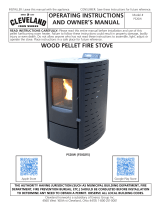
- 2 -
Safety Precautions
• IMPORTANT: Read this entire manual before
installing and operating this product. Failure to do
so may result in property damage, bodily injury, or
even death. The proper installation of this furnace is
crucial for safe and efcient operation.
• Contact your local building ofcials to obtain a
permit and information on any additional installation
restrictions or inspection requirements in your area.
• DO NOT throw this manual away. This manual has
important operation and maintenance instructions
that you will need at a later time. Always follow the
instructions in this manual.
• Never try to repair or replace any part of the furnace
unless instructions for doing so are given in this
manual. All other work should be done by a trained
technician.
• Install appliance and venting at clearances
specied in this manual.
• DO NOT connect the pellet exhaust vent to a vent
serving any other appliance or furnace.
• DO NOT install a ue damper in the exhaust venting
system of this unit.
• The use of outside air is not required for this unit but
is highly recommended. If installed into a tightly
constructed home, (Mobile Home) a fresh air
opening of at least 2” diameter (150mm) into the
room where the unit is installed is required. However,
return air make-up is required for maximum heat
distribution throughout your home.
• This heater is designed and approved as a multi-
fuel (corn or wood pellets) furnace. Use only dried
shelled corn with a moisture content of 11% or less
(which provides the best results). Pellet fuel used
should have an ash content of 1% or less. If not, the
performance and efciency of the unit will suffer,
and your warranty may be voided.
• Never use gasoline, gasoline-type lantern fuel,
kerosene, charcoal lighter uid, or similar liquids to
start or ’freshen up’ a re in this furnace. Keep all
such liquids well away from the furnace while it is in
use.
• A working smoke detector must be installed in the
same room as this product.
• DO NOT unplug the furnace if you suspect a
malfunction. Turn the On/Off SWITCH to ”OFF’ and
contact your dealer.
• Your furnace requires periodic maintenance and
cleaning (see ”Maintenance ”). Failure to maintain
your furnace may lead to improper and/or unsafe
operation.
• DANGER: Risk of Fire or Explosion - DO NOT BURN
GARBAGE, GASOLINE, NAPTHA, ENGINE OIL, OR
OTHER INAPPROPRIATE MATERIALS.
• Disconnect the power cord before performing any
maintenance! NOTE: Turning the On/Off Switch to
“Off” does not disconnect all power to the electrical
components of the furnace.
• Allow the furnace to cool before performing any
maintenance or cleaning. Ashes must be disposed
of in a steel container with a tight-tting lid. The
closed container of ashes should be placed on a
non-combustible surface or on the ground, well
away from all combustible materials, pending nal
disposal.
• The exhaust system should be checked monthly
during the burning season for any build-up of soot or
creosote. Creosote in your exhaust can potentially
cause a chimney re. In the event of a chimney re,
contact your re department immediately and press
the “Off” button on your furnace. Have a clearly
understood plan to handle a chimney re.
• CAUTION: Keep children away. Do not touch during
operation. Educate all children on the dangers of
a high-temperature furnace. Young children should
be supervised when they are in the same room as
the furnace.
• A power surge protector is recommended. This unit
must be plugged into a 110 - 120V, 60 Hz grounded
electrical outlet. Do not use an adapter plug or sever
the grounding plug. Do not route the electrical cord
underneath, in front of, or over the furnace. Do not
route the cord in foot trafc areas or pinch the cord
under furniture.
• The furnace will not operate during a power outage.
If a power outage does occur, check the furnace
for smoke spillage and open a window if any smoke
spills into the room.
• The feed door and ash pan must be closed and
sealed during operation to keep products of
combustion from escaping the furnace. Keep all
seals in good condition.
• Never block the free ow of air through the open
vents of the unit.
• Keep foreign objects out of the hopper.
• The moving parts of this furnace are propelled by
high torque electric motors. Keep all body parts
away from the auger while the furnace is plugged
into an electrical outlet. These moving parts may
begin to move at any time while the furnace is
plugged in.
• Do not place clothing or other ammable items on
or near this furnace.
• This appliance is not intended for commercial use.
• WARNING: DO NOT INSTALL IN SLEEPING ROOM.
• CAUTION: THE STRUCTURAL INTEGRITY OF THE
MANUFACTURED HOME FLOOR, WALL, AND CEILING/
ROOF MUST BE MAINTAINED.





















